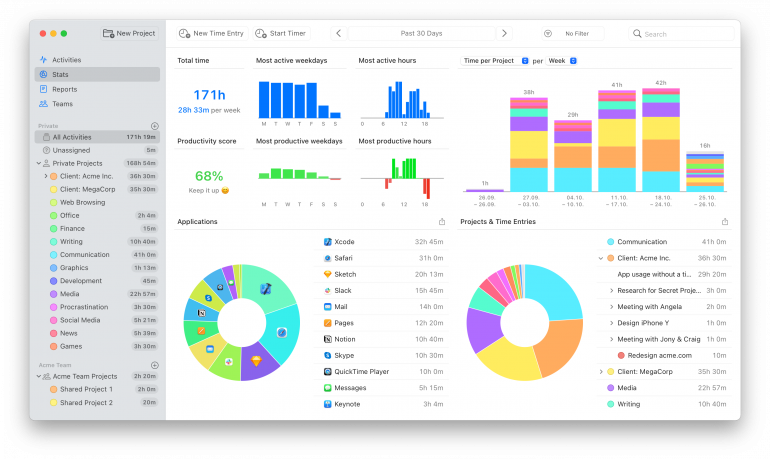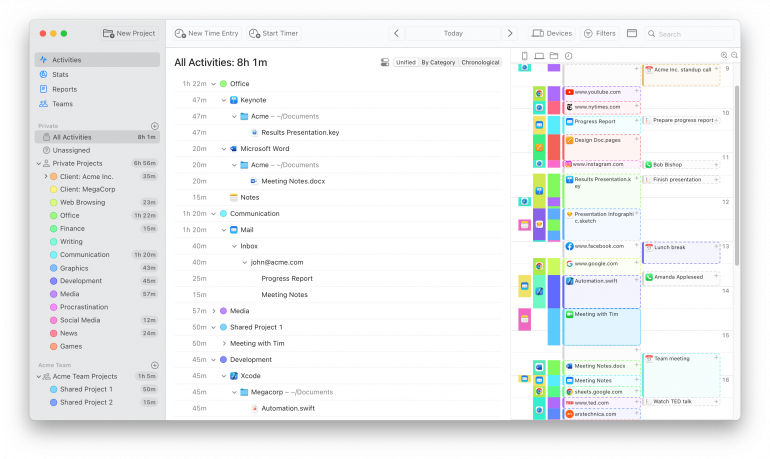Multitasking vs Multitasking Skills: Why Understanding the Difference is the Key to Greater Productivity
 Image: Generated with Dall-E
Image: Generated with Dall-E
There’s barely a job ad, resume or workplace intro pack that doesn’t stress the importance of multitasking. The ability to switch seamlessly between different tasks or projects, we’re constantly told, is an admirable quality — something we should all strive towards. But what is multitasking exactly, and is it deserving of such high praise? Should we be developing our multitasking skills instead?
Hang on a second. Multitasking vs multitasking skills? What’s the difference? Surely this is just a matter of semantics?
Not quite. While they’re related concepts, we’d argue that there are some important distinctions between the two. And improving your multitasking skills can help you get the most out of your attempts to multitask.
Table of Contents
What is Multitasking?
The term “multitasking” is a bit of a misnomer. It refers to the ability to work on and complete multiple tasks simultaneously. While this is relatively easy to achieve if your objective is to finish a bag of chips while watching TV, in the workplace, it isn’t usually possible. Most of us simply can’t do two tasks at once. At least not without compromising the quality of one or both.
Ever tried answering emails while listening to a conference call, only to find that you missed a question someone asked you? Or jumping from one project to another in an effort to complete them before close of business, but instead missing both deadlines? If so, you’re not alone.
In one study, only 2.5% of the participants surveyed were able to complete more than one task without performing them poorly. Almost everyone else — all 97.5% — performed worse than they would have if they’d only focused on one task.
When we attempt to multitask, what we’re actually doing is context switching. We’re leaping from one unrelated task to another. And this brings with it a host of problems. The practical and performance implications are just the start. We’ll explore these issues in more detail in a moment.
But the reality is that we’re likely always going to need to switch between tasks. The trick is to find a way to do this effectively.
 Image: Rock Staar
Image: Rock Staar
What are Multitasking Skills?
Unfortunately, very few of us have the luxury of Harper Lee, whose friends famously gave her a full year’s salary as a Christmas present in 1956 so that she could commit herself to writing full time. By the end of the following year, she’d written To Kill A Mockingbird, which has sold over 40 million copies worldwide.
The rest of us mere mortals, however, need to find a way to manage the many jobs on our to-do lists. And that doesn’t mean simply switching between them in a chaotic and disorganized manner. Instead, we need to develop the capabilities to manage multiple tasks while still being focused, productive, efficient, and meeting our goals and deadlines.
Enter multitasking skills.
Having multitasking skills is slightly different to simply doing multiple things at once. It places the focus on the abilities and competencies needed to do multiple things well. Without stretching your focus too thin and without compromising the quality of your work.These skills include learning how to manage your time, prioritize your tasks, set realistic goals, and minimize distractions.
It’s important to remember that, while developing your multitasking skills is a practical necessity, a related skill is learning to spot the limitations of multitasking. Doing many things simultaneously doesn’t always serve you. And there are times when it’s beneficial to concentrate exclusively on one task before moving onto the next.
The Problems and Pitfalls of Multitasking
Attempting to do multiple tasks isn’t without its problems. In fact, if it’s managed badly, there might be more pitfalls than potential. Beware of the following issues:
- Multitasking doesn’t make you more productive: Just because you’re flitting between tasks, doesn’t mean that you’re doing them well. Or that you’re working on them productively. Productivity often requires dedicated focus on the task at hand.
- You lose control of your time: Because your mind has to recalibrate every time you tackle a new task, you’re wasting precious minutes when you multitask. Using an automatic time tracking tool like Timing can help you identify where your time is going. You might be better off time blocking your calendar to help you work more efficiently.
- You’re prone to making mistakes: Thinking of a previous task while suddenly switching to a new one can affect your concentration. This makes it more likely that you’ll introduce mistakes into your work. Having to go back to check on work you’ve already completed further thwarts your productivity.
- It causes anxiety: According to this study, people compensate for the constant interruptions involved in multitasking by working quicker. This isn’t necessarily a good thing, though. This frantic working behavior often causes feelings of stress, anxiety and frustration.
- It affects your memory: Distractions and interruptions affect your short-term or working memory. This means that multitasking can interfere with your ability to retain information and learn new things. And this can get worse as you get older.
- Multitasking reduces creativity: Completing innovative and creative tasks requires time and mental capacity. Unfortunately, both are sacrificed when you attempt to multitask. If you’re trying to do complex work that requires creative thinking and problem solving, you’re better off siphoning off some dedicated time to work uninterrupted.
But the need to multitask, as we’ve already established, is here to stay. Our working lives simply have too many components and commitments. We have to attend meetings, develop pitches, stay on top of our invoicing, and complete both small and in-depth projects. It’s important that we find a way to work on multiple things, while avoiding these pitfalls.
In other words, we need to refine our multitasking skills.
 Image: Agence Olloweb
Image: Agence Olloweb
What are Some Examples of Multitasking Skills?
So, how do you get multitasking right? What are the skills you should develop if you want to be able to work on multiple projects without falling into the traps above? Start by learning how to:
1. Prioritize your tasks
Identify the most important tasks you need to complete and focus on them first. There are several different criteria to consider here. Your most important task might be the project with the most urgent deadline, or the one that requires the most work. Or it might be worth more financially. Listing your tasks based on the right criteria will help you to allocate your time and attention to those that matter most.
2. Set realistic goals
Avoid overloading yourself with too many tasks. Be realistic about what you can accomplish in a given time frame. (Hint: It’s probably less than you think.) And don’t be afraid to delegate or say no if you need to. Setting work boundaries is an important multitasking skill. It involves being open and firm about what you can work on when. And what time and energy commitments are required for you to meet your deadlines.
3. Minimize distractions
Create a distraction-free work environment. Turn off non-essential notifications and close unnecessary browser tabs or apps. (A tool like Focus can help you here.) You might also want to inform colleagues or family members about your focused work periods.
4. Identify when multitasking isn’t appropriate
There are inevitably going to be periods of the day when you need to switch between tasks. You might have to send a few emails, finalize a quote or two, and prepare to fetch your teenager from football practice. (Remember to take your personal life into account as you consider how best to multitask.)
But there are times when you need to set aside dedicated time to do focused deep work. This is important. It’s the time when you’re likely to do your most strategic, innovative and creative thinking. This can help to improve your reputation for quality work, and help to distinguish you from your peers and competitors.
One of the most important multitasking skills, in other words, is knowing when not to multitask.
5. Practice time blocking
Time blocking is the practice of dividing your day into blocks of time. This can help you to assign certain periods to multitasking, and other periods to focused work.
A handy trick is to organize your focused work around the times of the day when you’re most productive. Your Timing Stats page can help you here. Simply take a look at the days of the week when you’re most productive. Below, you can see that this is on Tuesday, Wednesday and Thursday between midday and 4pm. Your most productive hours might be first thing in the morning, or late at night.

Whatever the case, time block your productive periods for working on mentally demanding projects. And block off hours when you’re generally not as productive for your multitasking activities.
6. Cultivate mindfulness
Develop the habit of mindfulness. This involves being fully present in the moment, and focused on the task at hand. Mindfulness can help you stay absorbed in your current task and reduce your levels of stress. Introducing a regular meditation practice into your schedule can help to improve mindfulness in other areas of your life.
7. Take regular breaks
It’s essential to take short work breaks between tasks to recharge your energy and maintain your productivity. Try using the Pomodoro technique, which involves working for 25 minutes and then taking a five-minute break.
You might also choose to take a power nap, go for a walk, have a nutritious snack, or meditate. Different types of breaks might work better at different times of the day. Experiment to see which option suits you best and when.
8. Reflect and adjust
Regularly assess your multitasking habits and how they’re affecting your productivity and well-being. Are you working efficiently and productively? Is the quality of your work where it should be? Do you have a good work-life balance?
Make sure you’re managing to multitask without feeling unfocused, unproductive and stressed. That way, you’re reaping the rewards while mitigating the risks.
Timing: Your Multitasking Skills Assistant
Putting these skills in place can feel a little daunting initially. Especially if you’re a chronic multitasker who is familiar with a frenetic, thinly stretched schedule. Fortunately, you don’t have to do it alone.
By using an automatic time tracking tool, you can start to get a handle on how you spend your time. Timing runs in the background while you work. You don’t need to log anything manually (unless you choose to). Instead, it automatically keeps track of every document, website and app you open. This means it’s capable of giving you detailed insight of when you’re multitasking and when you’re focusing on one, dedicated project. Your Activities tab will offer all of this information.

This can help you identify how much of an issue multitasking is for you. And whether you might benefit from investing in the multitasking skills we’ve listed.
By using Timing’s Screen Time and phone call integration features, you can also get a sense of whether you’re losing valuable minutes to distracting tasks. Are you scrolling on social media when you should be doing focused work? Are phone calls disrupting your flow? Both down time and phone calls are important, but scheduling them during the time you’ve set aside for multitasking can help you stay on top of your work.
As you put your multitasking skills into practice, you might want to do a time audit. This will help you to see whether your efforts to multitask constructively are working. Or whether there are still some improvements you can make.
Unlocking Your Multitasking Skills: Strategies and Tips
So, how do you refine your multitasking skills so that you can get the best out of multitasking while avoiding the pitfalls? Following these tips will set you on the right path.
- Find a time management technique that works for you: Multitasking is unavoidable. What matters is that you do it well by managing your time efficiently. How you do this is totally up to you. You might opt for the Pomodoro method, or choose to block your time. Experiment to find a technique that fits your working style best.
- Use technology to your advantage: Automate easy and repetitive tasks so that they don’t weigh you down. Free up as much time to think creatively (including figuring out how you can handle your multitasking better).
- Introduce a time tracking tool into your workflow: Gain valuable insight into how you spend your time with an automatic time tracking tool. This will help you to identify whether you tend to switch between tasks too much. It will also reveal times of the day when you’re more and less productive. Scheduling your multitasking activities for your less productive hours will help preserve your productive time for deep work.
Start by trying Timing’s free 30-day trial. It will help you examine and rectify your poor time management habits so that you can refine your multitasking skills, and use them to your advantage.
Multitasking Skills: Frequently Asked Questions
What are multitasking skills?
Multitasking skills are the capabilities that help you to complete multiple tasks effectively. They’re the skills necessary to manage a busy schedule, without falling into the traps of multitasking. These can include compromising quality, focus and productivity, and making stress and anxiety worse.
What is an example of a multitasking skill?
There are several different multitasking skills you should nurture in order to work productively and efficiently. They include prioritizing your tasks, setting realistic goals, and minimizing distractions. You should also be able to identify when multitasking doesn’t serve you, and when you should set aside time for deep work instead.
How do I develop multitasking skills?
Developing your multitasking skills involves finding a time management technique that works for you. This will help you gain a high-level overview of your time, so that you can start to implement the skills that will help you work productively.
How do I improve my multitasking skills?
One of the most important ways of improving your multitasking skills is knowing where your time goes. Using an automatic time tracking tool will help you to keep track of how you spend your hours and minutes. With this valuable insight, you can identify when you’re most productive, and adjust your working schedule accordingly.
